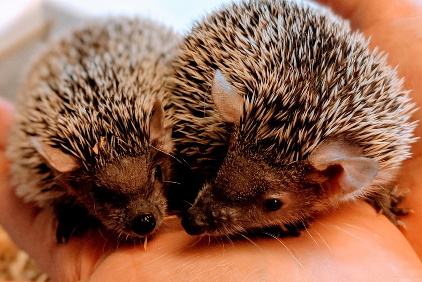Overview of Lesser HedgehogTenrecs
The family name Tenrecidae, common name Tenrecs, is a family of mammals endemic to Magagascar and parts of Africa. They occupy the same ecological niche as hedgehogs would do, and are often used as an example of convergent evolution. Tenrecs are a very diverse species, which can resemble moles, shrews, hedgehogs or Otters. Currently there are about 5 species of tenrec in the pet trade, the lesser Madagascar tenrec, common/tailless tenrec, greater Madagascar tenrec, lowland streaked tenrec, & highland streaked tenrec.
The Lesser Hedgehog Tenrec is the commonly available pet tenrec. Lesser Hedgehog Tenrecs would naturally live in forests, savanna, shrubland or grassland in Madagasgar. Pet tenrecs are similar in appearance to the hedgehog, with some differences including a short spine-covered tail. Despite the name, they are actually more closely related to elephants, manatees and aardvarks than hedgehogs.
Lesser Hedgehog Tenrecs measure from 5 - 6.8 inches and typically weigh around 130-200g, they have a long snout, small beady eyes and a short spine-covered tail. Pet tenrecs have a good lifespan at between 7-10 years with the correct care.
Tenrecs do not reproduce readily in captivity, breeding only in spring so it is possible to keep a male and female pair together year-round without the risk of back-to-back litters. Gestation is 60-70 days with weaning at 3-4 weeks of age. Baby tenrecs grow very rapidly and require a great deal of food. Breeding tenrecs should only be done with extensive research and if prepared to house all young yourself separately if suitable, specialised homes cannot be found.
Tenrecs are insectivores and so this should form the majority of their diet. Items such as crickets, earthworms, locusts, mealworms, Morio worms (sometimes referred to as super giant mealworms) roaches, slugs, snails and waxworms. The remaining 10% of their diet should consist of fruits such as apricot, banana, papaya, and peaches. Other items to offer include fruit yoghurt, hard-boiled egg, pinkies and day-old chicks. It is important to supply a calcium supplement, which can be done by dusting live food and then tong-feeding to ensure you know what each tenrec is eating. A calcium supplement can also be added to their water.
Unlike African Pygmy Hedgehogs Pet Tenrecs can be housed together if female, although you can only have one male tenrec per cage. It is important to note that you cannot sex a pet tenrec without a DNA test as their reproductive organs are all internal and the male penis only comes out during breeding. Female tenrecs have a cloaca (a single reproductive, intestinal and urinary opening) rather than the separate openings most typical mammals have. From 6 months onwards, visual differences between the sexes appear - such as the male's broader face and puffy rings around the eyes. Males can secrete a milky white substance from their eyes, however, some females do also do this and sexing visually is not fully accurate. A DNA test using saliva is the only way to be sure of your pet tenrec's sex.
Pet Tenrec care has some additional setup and costs, such as the need for a heat source such as an overhead heat lamp or ceramics.Pet tenrecs benefit from a more arboreal habitat than hedgehogs, being excellent climbers. Branches, cork tubes and stumps make excellent additions to their setup. They must have a hide to sleep in during the day and many pet Tenrecs enjoy running on a wheel. Unlike other pets, a wire wheel with gaps is considered safe by many exotic keepers as tenrecs are not in danger of breaking legs.
Pet Tenrec care has some additional setup and costs, such as the need for a heat source such as an overhead heat lamp or ceramics. A large vivarium is easier to heat than a metal barred cage and it is important to keep a temperature measure so you can monitor temperature across the seasons to keep at their required range (22°C - 26°C).
They will be very active during the summer months but enter a state of brumation or torpor during the winter months. This differs from hibernation as there are different metabolic processes involved. Whilst in this state they will eat very little and once out of brumation they will eat extra to offset this. It is important to regularly weigh your Pet Tenrecs, especially if it is their first torpor.
Tenrecs are very confident animals and can make excellent pets. They have very distinct characters and are easy to handle.

